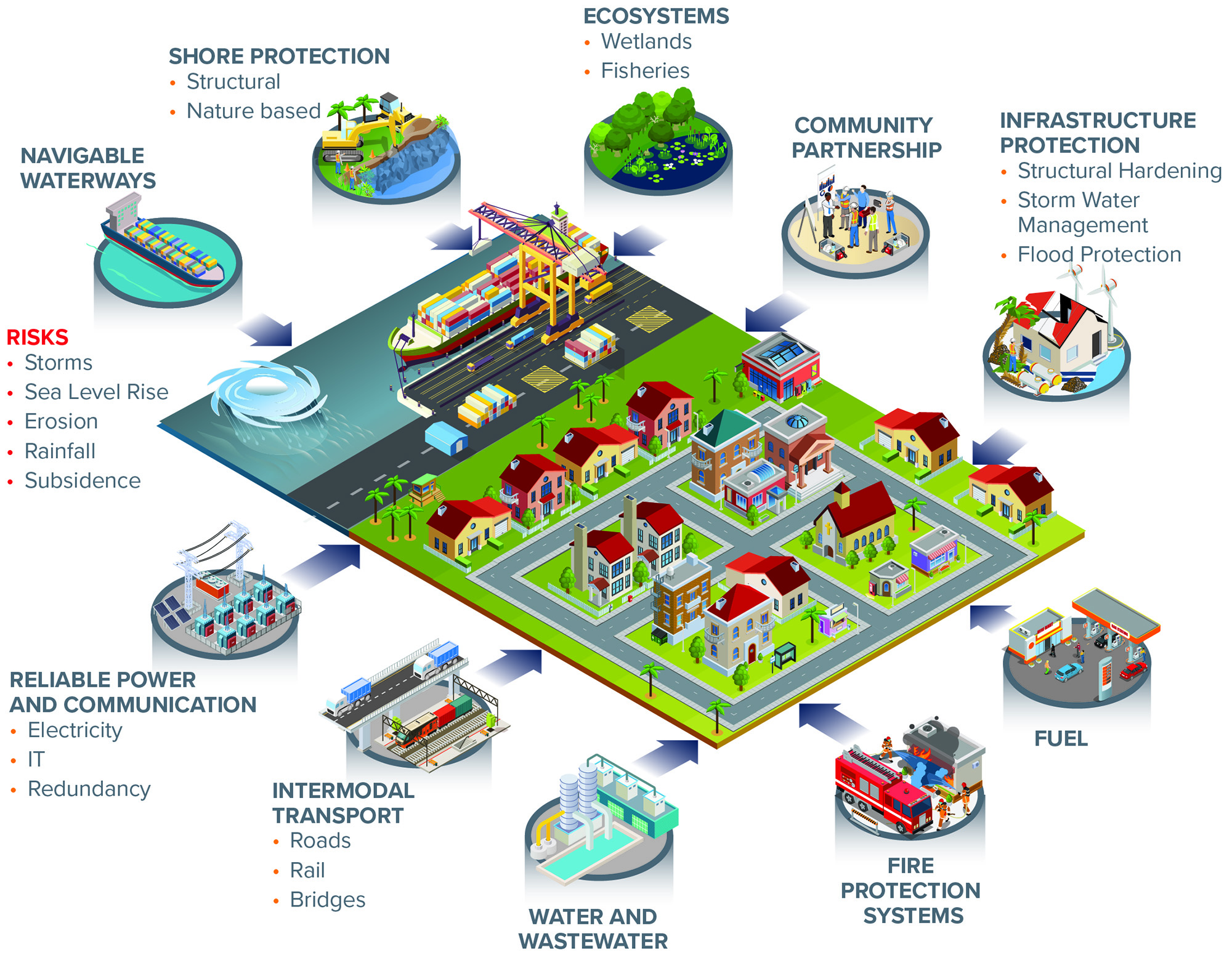By Paul Tschirky, Ph.D., P.Eng, BC.CE, M.ASCE
As 2023 came to a close, reports of record-breaking temperatures and billion-dollar disasters — including floods, wildfires, extreme storms, and hurricanes — filled the news. One region heavily impacted by changing climate is the boundary where land and water meet. The need for resilient approaches that address the interaction of critical built infrastructure and ecosystems along shorelines has never been more pressing. Coastal and shoreline regions have large and growing populations, critical infrastructure, and valuable habitat.
When it comes to designing more resilient solutions along the water’s edge, what are the challenges, opportunities, and approaches?
Understanding hazards
Understanding hazards specific to the area, from a historical perspective and with consideration for how they may change in the future, is the first step in developing resilient solutions. In coastal areas, key hazards may include:
- Sea level rise.
- Changing precipitation (frequency, intensity, and distribution).
- Severe storms, including hurricanes.
- Storm surge and waves.
- Erosion.
- Subsidence.
- Tsunamis.
- Riverine or surface flooding.
These hazards can interact and compound effects. For example, rising seas can allow storms to penetrate farther inland and increase erosion potential and flooding extents. These impacts can be further magnified by aging infrastructure and growing coastal populations.
Balancing risks
Understanding potential hazards is just the first step; to develop solutions that best allocate resources, the risk must be evaluated. Risk is a function of the hazard, its probability, and the criticality of the impact. Questions to ponder include: How likely is the hazard to occur? What are the consequences if it does? How serious are those consequences?
In addition, social implications (e.g., equity and cultural resources) and political and environmental impacts must be weighed. Resilient solutions balance built infrastructure and natural environments while meeting the needs of the community. The most successful approaches involve engaging a broad range of stakeholders and multidisciplinary experts from the onset so that solutions holistically incorporate physical risk reduction, community needs, and ecology.
While there are many definitions of resilience, there are generally four common elements:
- Anticipating, preparing, and planning for a disruption or event.
- Withstanding and resisting the event.
- Recovering rapidly from disruptions.
- Adapting to be better prepared for future disruptions.
True resilience is a comprehensive, cyclical approach to acute disruptions and long-term changes through which the amount of damage and time to return to functionality is reduced for subsequent future disruptions.
Building resilience
Elements for enhancing resilience can involve physical and social approaches.
Physical measures include engineered structures (such as sea walls, levees, breakwaters, revetments, storm surge barriers, drainage improvements, floodwalls, and gates), nature-based approaches (such as sediment management, beaches and dunes, wetlands, living shorelines, and reefs), and technology (such as modeling, mapping, monitoring, water management systems, and warning and evacuation systems).
Resilience approaches in design can include:
- Reinforcing or hardening the system or system elements to withstand larger events.
- Avoiding the hazards through increased setback distances or relocating portions of infrastructure to higher ground.
- Providing redundancy through backup systems or pre-positioned supplies.
These approaches and elements can be used together to create multiple lines of defense or hybrid approaches that use built elements and nature-based elements.
Social measures that can be used include education (such as tools, mapping, and accurate and understandable information for the public and decision-makers), stewardship (such as nongovernmental organizations and community and school programs), and government (such as policy and regulations, land use, building codes, acquisition, and incentives).
Coasts are well suited for multilayered/multiple lines of defense approaches that can use various elements onshore and offshore to complement one another. For example, restoring or creating adjacent wetlands reduces hazard impacts and provides storm buffering, flood storage, and erosion reduction. Using engineered structures, such as breakwaters or artificial reefs, can help create conditions where vegetation can establish in nearshore areas. Other approaches — such as leaving space adjacent to infrastructure for natural migration of wetlands with rising water levels or building wider, flatter features that can be elevated in the future — allow for adaptation as conditions change.

Using multiple layers of defense provides improved risk reduction and multiuse opportunities. Multiuse solutions can help gain much-needed community, political, and financial support. For example, flood protection berms can serve not only as storm buffers but provide a space for recreational trails.
A resilient tomorrow
Shorelines and associated habitats are often critical first lines of defense from natural disasters for waterfront infrastructure and communities. To provide resilience along the water’s edge, the hazards and risks present now and under future conditions must be assessed.
A waterfront community’s resilience depends on the success of each element of its interconnected systems. For example, a surviving business is of little value if its workers’ and customers’ homes are destroyed during a disaster. Understanding the combined influences of multiple hazards, such as increased intensity precipitation and storm surges, is required to fully assess the risks and plan and design solutions that create more resilient and sustainable outcomes. This must happen from the start of design.
Resilient solutions require collaboration, innovation, and problem-solving. Civil engineers can lead in meeting these challenges today to help our communities achieve a more resilient tomorrow.
Paul Tschirky, Ph.D., P.Eng, BC.CE, M.ASCE, leads APTIM’s resilience practice, offering fully integrated solutions for the infrastructure needs of government, commercial, industrial, and energy customers to enhance the environment, well-being, and resilience of communities.
This article is published by Civil Engineering Online. It is based on a conference paper, Resilience Implications Where Land and Water Meet, which was presented at the 2023 ASCE INSPIRE Conference.
The content provided in this article is for general informational purposes only.



